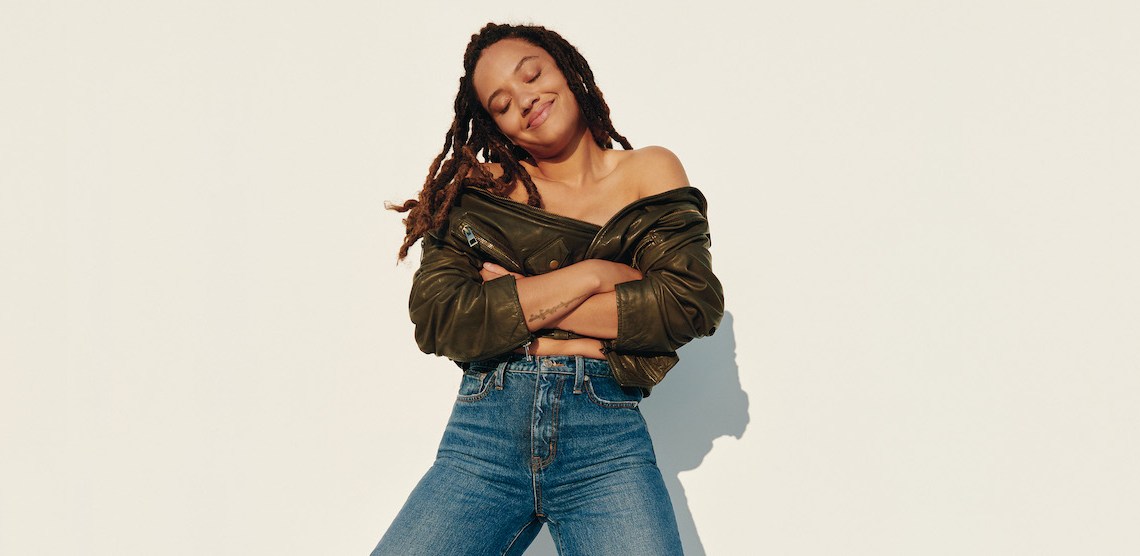Madewell launched its latest ad campaign on Tuesday, called “When the Fit Hits.” Under CMO Derek Yarbrough, the campaign is meant to appeal to both Madewell’s growing Gen-Z demo and its existing millennial core audience. It centers on Madewell’s denim and, particularly, the wider array of fits that the brand has introduced to match changing trends in denim silhouettes.
“When the Fit Hits” is rolling out across a number of platforms, including TikTok, Instagram and YouTube. Yarbrough said one of the key aspects of the brand’s marketing strategy is to tailor campaigns to fit the platform they’re premiering on.
“The goal is to stay true to the platform while staying true to the brand,” Yarbrough said. “TikTok is having explosive growth at the moment, so [we need to find out]: What is TikTok about and what is Madewell’s place on it?”
Yarbrough said, in his estimation, TikTok users value entertainment and education. So the brand centered its strategy on a combination of quick, easy videos showing off its new products and tutorials on how to turn a pair of jeans into shorts. On TikTok, Madewell featured young celebrities like actors Lukas Gage of HBO’s “The White Lotus” and Charlbi Dean of The CW’s “Black Lightning”. The celebrities anchor the main campaign, starring in short videos showing off pieces from the fall denim collection. Certain pieces will also show up on TikTok influencers’ accounts, though Madewell declined to say how many creators it is working with on the platform.
Meanwhile, a different evergreen TikTok campaign that launched on August 10 and provides information on Madewell’s trade-in program has been viewed more than 400,000 times and shared 3,000 times. Madewell has nearly 8,000 followers on TikTok.
Instagram, meanwhile, is a more sophisticated ad platform that’s better suited to serve as a top-of-funnel marketing tool, Yarbrough said. The “When the Fit Hits” campaign on Instagram will take a slightly different form, focusing on high-res product imagery showing off specific pieces from the fall denim collection, rather than short video content. However, the same content from TikTok will also be repurposed for Instagram’s Reels section. Madewell has 1.4 million followers on Instagram.
The final piece of the platform puzzle for Madewell’s new campaign is YouTube. It’s a platform that doesn’t get as much attention in fashion circles as Instagram, but Yarbrough called it a powerful marketing tool. He described YouTube as a full-funnel marketing platform, with high-level opportunities through YouTube TV, one of the fastest-growing CTV options. On the lower end of the funnel, Madewell tapped into the popularity of shopping haul videos, seeding products to over a dozen creators to take advantage of the high volume of searches on YouTube for the brand’s name. The brand has around 6,300 subscribers on YouTube. Madewell declined to disclose its ad spend on TikTok, Instagram and YouTube.
Ad position: web_incontent_pos1
“YouTube is an awesome platform, very multifaceted,” Yarbrough said. “The everyday volume of people searching for how-tos and inspiration is huge, and it’s very distinct.”
Yarbrough said Madewell’s campaign rollout strategy has gone largely unchanged even as the larger company J.Crew Group has undergone changes. Libby Wadle took over as CEO of the group in late 2020, and J.Crew has sought out a new identity under the newly appointed men’s creative director, Brendon Babenzien, and evp of women’s design, Olympia Gayot. J. Crew’s last reported revenue figures were in 2019, at more than $2.5 billion, before it went bankrupt in 2020.
Navigating the differences and uses of these platforms is key for brands right now, according to Andrew Duffy, co-founder and CEO of retail software company SparkPlug. That’s especially as the costs for using them are increasing.
“It doesn’t make sense to rely on consumers to impulse buy expensive, buzzy products from an Instagram ad in this economy,” Duffy said. “Piling onto that is the fact that cost-per-click advertising on brands’ old mainstays like Facebook, Instagram, YouTube and Google has been increasing in price for years.”




